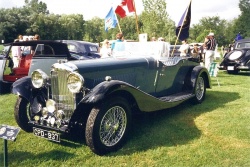 1934 Lagonda M45R. Click image to enlarge |
Article and photo by Bill Vance
Although Lagonda was a grand old name in English motoring, it was also one with an international pedigree. The company was started by transplanted American Wilber Gunn who moved to Britain in the 1890s hoping to become a professional singer. And much later Lagonda was saved for a period by Canadian George Minden of Toronto and American Peter Sprague who bought the wobbly remains in 1975. It was sold to Ford Motor Company in 1987, which sold it in 1997. A lot happened between Gunn and Ford.
A singing career didn’t materialize for Gunn, but he discovered a keen interest in the internal combustion engine, which led him to design a motorcycle by 1898. He sold several of them, and moved on to a three-wheeled vehicle with handlebar steering and passenger seat between the two front wheels. One of these Tricars captured a gold medal in the 1905 Auto Cycle Club reliability run.
In 1907, Gunn abandoned three wheelers and formed Lagonda Motor Co., to build “proper” four-wheelers in a building in the garden of his Staines, Middlesex home. The Lagonda name came from a river in Springfield, Ohio, Gunn’s home town.
Lagonda four-cylinder cars soon distinguished themselves by winning more gold medals. They developed a variety of four and six-cylinder models, one of note being the 1913 20 Horsepower, competing with low priced models like Morris, Ford, Hillman and Singer. Its 1.1-litre four had overhead inlet valves and side-valve exhausts, called an F-head design. In a form of unit construction, the sheet steel body was attached directly to the frame.
In the 1920s, Lagonda left the low-priced field to build the luxury and higher performance, sporty cars for which it became best known. The Two Litre four arrived in 1926 with overhead valves operated by two camshafts high in the block, a design also used by Riley and Lea Francis. Supercharging was tried but didn’t work out. A better idea was adding two cylinders to create the 1926 Two Litre six.
Lagonda models proliferated to where it was straining the little factory that had grown like Toppsy in Mr. Gunn’s garden. One of the most notable was the M45 which appeared in 1933, a large car that aspired to the Bentley class. Its 3.0-litre, 92-horsepower six could push it beyond 145 km/h (90 mph). A year later, it was joined by the M45R (Rapide), with a stronger crankshaft and higher compression and capable of 161 km/h (100 mph). Also added was the Rapier, a smart, good handling smaller model powered by a double overhead cam 1.1-litre four. Lagondas now stretched to both ends of the automotive spectrum.








